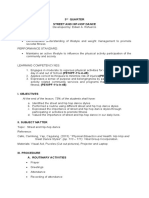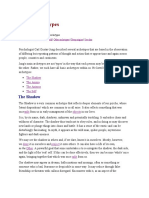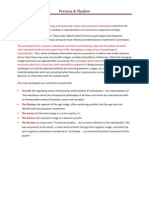Professional Documents
Culture Documents
Number 6-TOP-JUNG
Number 6-TOP-JUNG
Uploaded by
aileen elizagaOriginal Description:
Original Title
Copyright
Available Formats
Share this document
Did you find this document useful?
Is this content inappropriate?
Report this DocumentCopyright:
Available Formats
Number 6-TOP-JUNG
Number 6-TOP-JUNG
Uploaded by
aileen elizagaCopyright:
Available Formats
6.
Identify and explain the different archetypes in relation to the study of personality
Jung suggested a series of archetypes such as: the father (authority figure), the mother (nurturing), the
wise old man (wisdom, knowledge), the hero (champion, rescuer), the trickster (troublemaker), among
others. However, there are four (4) major Jungian Archetypes: the persona, the anima and animus, the
shadow, and the self.
Jung’s Theory of the Psyche Archetype-The Persona (Represents your public image). The word is,
obviously, related to the word person and personality, and comes from a Latin word for mask. So the
persona is the mask you put on before you show yourself to the outside world. This usually protects the
Ego from negative images (acts like a mask). Although it begins as an archetype, by the time we are
finished realizing it, it is the part of us most distant from the collective unconscious.
The Anima/Animus (the feminine side of the male). The anima is the unconscious image of the
feminine that every man has within himself. Jung wrote: ‘Every man carries with him the eternal image of
woman. This image is fundamentally unconscious, an imprint of all the ancestral experiences of the
female, a deposit of all the impressions ever made by woman.’.
Animus (masculine side of the female) similar to a man, every woman carries within her the eternal image
of a man. In the same way that man has an unconscious anima, woman has an unconscious animus which
consists of “masculine” characteristics. This is also an active force on the woman who is unconscious of
its presence. The way to remove the negativity of the animus and to live in harmony with him is for
woman to differentiate between her ego and the animus instead of assuming them to be one as she
unconsciously does. Similarly, the man has to differentiate between his ego and the anima. This is
achieved by individuation dealt with later.
Jung’s Theory of the Psyche Archetype-The Shadow (contains the evil side of humanity). It derives
from our pre-human, animal past, when our concerns were limited to survival and reproduction, and when
we weren't self-conscious. It is an archetype of darkness and repression, represents those qualities we do
not wish to acknowledge but attempt to hide from ourselves and others. The shadow consists of morally
objectionable tendencies as well as a number of constructive and creative qualities that we, nevertheless,
are reluctant to face (Jung, 1951/1959a).
Jung’s Theory of the Psyche Archetype-The Self (archetype of wholeness). The Self can be understood
as the central organizing principle of the psyche, that fundamental and essential aspect of human
personality which gives cohesion, meaning, direction, and purpose to the whole psyche. It is who you
believe you are.
You might also like
- Lesson Plan Final! - Hip Hop and Street Dance StylesDocument3 pagesLesson Plan Final! - Hip Hop and Street Dance StylesJan Abigail100% (5)
- Carl G. Jung's Theory of Analytical PsychologyDocument4 pagesCarl G. Jung's Theory of Analytical PsychologyBasil Lipcan50% (2)
- Anima and AnimusDocument4 pagesAnima and Animusimam masngud100% (1)
- Anima and Animus Term ReportDocument17 pagesAnima and Animus Term ReportSadia Shahid100% (1)
- Carl Gustav JungDocument10 pagesCarl Gustav Jungjhon albert100% (1)
- Mnemic Neglect and Dual Processes: Karolyn Budzek Attention & Memory Fall 2007Document13 pagesMnemic Neglect and Dual Processes: Karolyn Budzek Attention & Memory Fall 2007Karolyn ChowningNo ratings yet
- ArchetypesDocument23 pagesArchetypesmaazyounus8126No ratings yet
- Levels of ConsciousnessDocument11 pagesLevels of ConsciousnessRajat Raj VermaNo ratings yet
- ArchetypesDocument6 pagesArchetypesifatimanaqvi1472No ratings yet
- The Freudian TheoryDocument12 pagesThe Freudian TheoryroqueNo ratings yet
- Carl Jung PPT EmmanuelDocument19 pagesCarl Jung PPT EmmanuelRuth Ignacias Jumao-asNo ratings yet
- Archetypal CriticismDocument18 pagesArchetypal CriticismKenneth Charles OñezNo ratings yet
- Personal DevelopmentDocument3 pagesPersonal DevelopmentAce ChianNo ratings yet
- Example of An Expository EssayDocument2 pagesExample of An Expository EssayAbbi MeiNo ratings yet
- Psychodynamic and Analytic Perspective of The Self Reported by Group 1Document24 pagesPsychodynamic and Analytic Perspective of The Self Reported by Group 1Maria Elisa RubricoNo ratings yet
- I: Introduction of Carl JungDocument4 pagesI: Introduction of Carl JungThe BlackOrderNo ratings yet
- Carl JungDocument6 pagesCarl JungSnowdenKonanNo ratings yet
- Carl JungDocument24 pagesCarl JungSteven Claude TanangunanNo ratings yet
- Carl Jungs Theory of Personality Archetypes and Collective UnconsciousDocument14 pagesCarl Jungs Theory of Personality Archetypes and Collective UnconsciousJonathan NguyenNo ratings yet
- ArchetypeDocument8 pagesArchetypeFedericoSolhNo ratings yet
- Expository EssayDocument3 pagesExpository EssayAbbi MeiNo ratings yet
- Archetype: EtymologyDocument4 pagesArchetype: EtymologyAndre Maurice ReyNo ratings yet
- Carl Jung's TheoryDocument11 pagesCarl Jung's Theorynmafavour2No ratings yet
- Theories of Personality Psyche: The Principle of EquivalenceDocument3 pagesTheories of Personality Psyche: The Principle of EquivalenceCelape CabanesNo ratings yet
- Map of The SoulDocument3 pagesMap of The SoularwjuzNo ratings yet
- 4 Archetypes of Carl JungDocument3 pages4 Archetypes of Carl JungMichElle DanFord50% (2)
- Anima and Animus: Calgary Jung Society! Core Concepts #4Document6 pagesAnima and Animus: Calgary Jung Society! Core Concepts #4AnaNo ratings yet
- Jung's Archetypes: The ShadowDocument3 pagesJung's Archetypes: The Shadowimo mamaNo ratings yet
- Intro To Pi and TheoriesDocument34 pagesIntro To Pi and TheoriesJason Phil BaileyNo ratings yet
- Persona & ShadowDocument5 pagesPersona & ShadowAkanksha MalhautraNo ratings yet
- Carl Jung Lec 1Document6 pagesCarl Jung Lec 1anaumnawaz50No ratings yet
- The Structure of The PsycheDocument3 pagesThe Structure of The PsycheAgam SegalNo ratings yet
- Biographical Sketch: Personality'S Ancestral Foundations: Carl JungDocument11 pagesBiographical Sketch: Personality'S Ancestral Foundations: Carl JungChris DavisNo ratings yet
- CarljungDocument15 pagesCarljungHya Patayan Gultiano-EllorinNo ratings yet
- About JungDocument1 pageAbout JungAnton StockNo ratings yet
- Jungian ArchetypesDocument8 pagesJungian ArchetypesJelena Dobric100% (1)
- Dead BrainDocument19 pagesDead Brainjennycastillo442No ratings yet
- Jung Analytical TheoryDocument10 pagesJung Analytical Theorycocodream742No ratings yet
- Theories of Personality 123 126Document4 pagesTheories of Personality 123 126Wandanisa WandaNo ratings yet
- Carl JungDocument10 pagesCarl JungChristine PeñamanteNo ratings yet
- ArchetypesDocument17 pagesArchetypesVERITYjnanaZETETIC100% (15)
- The JungianDocument3 pagesThe JungianfangimerNo ratings yet
- Carl Gustav Jung TheoryDocument25 pagesCarl Gustav Jung TheoryLiana OlagNo ratings yet
- Carl Jung'S Analytical Psychology: Subject: Theories of Personality Perspective: PsychodynamicDocument14 pagesCarl Jung'S Analytical Psychology: Subject: Theories of Personality Perspective: PsychodynamicParokya Ni TomasNo ratings yet
- Psy370 Cloninger Ch03 Lecture HandoutDocument14 pagesPsy370 Cloninger Ch03 Lecture HandoutZserimaia Gerardo BangsaliwNo ratings yet
- My Paper Jungian TheoryDocument13 pagesMy Paper Jungian TheoryVitria MbindiNo ratings yet
- Carl JungDocument17 pagesCarl JungShahfahad JogezaiNo ratings yet
- Carl JungDocument30 pagesCarl Jungjoy ann ganadosNo ratings yet
- Carl JungDocument1 pageCarl JungHammad AliNo ratings yet
- Jung IndividuationDocument11 pagesJung IndividuationphotopoesisNo ratings yet
- Theories of Personality7Document4 pagesTheories of Personality7HASDIN ABKARIAN EBRAHIMNo ratings yet
- Jung Part 2Document5 pagesJung Part 2kaedeharakaydenNo ratings yet
- Valenzuelakristina G.CG 601 Carl Jungs Analytic TheoryDocument6 pagesValenzuelakristina G.CG 601 Carl Jungs Analytic TheoryEduardo TalamanNo ratings yet
- Lesson 3. Analytical Theory Carl Jung PDFDocument5 pagesLesson 3. Analytical Theory Carl Jung PDFMaja Aira BumatayNo ratings yet
- Carl Jung What Are The Archetypes Quote BookDocument8 pagesCarl Jung What Are The Archetypes Quote BookGlows100% (6)
- 0 - Share THE COLLECTIVE UNCONSCIOUSNESSDocument7 pages0 - Share THE COLLECTIVE UNCONSCIOUSNESSMuhammed AbubakarNo ratings yet
- How To Expand Your Consciousness Using ArchetypesDocument19 pagesHow To Expand Your Consciousness Using ArchetypesGen RepeNo ratings yet
- Narrativa IIDocument19 pagesNarrativa IILaura BznNo ratings yet
- Jung Analytical PsychologyDocument35 pagesJung Analytical PsychologyRonnie NalupaNo ratings yet
- Carl Jung & Alfred Adler Theories of Perosnality: Personality PsychologyDocument24 pagesCarl Jung & Alfred Adler Theories of Perosnality: Personality PsychologyVira IzzaniNo ratings yet
- Carl Gustav JungDocument26 pagesCarl Gustav JungRoma Ledesma100% (1)
- Tarot Shadow Work: An Innovative Guide to Unleashing Your Untapped Potential, Awakening Inner Wisdom, and Discovering the Power of Your Hidden Self with the Tarot's Major ArcanaFrom EverandTarot Shadow Work: An Innovative Guide to Unleashing Your Untapped Potential, Awakening Inner Wisdom, and Discovering the Power of Your Hidden Self with the Tarot's Major ArcanaNo ratings yet
- Pe 13 Dance Exercise IDocument3 pagesPe 13 Dance Exercise Iaileen elizagaNo ratings yet
- Pe13 Lesson 1-PopdanceDocument10 pagesPe13 Lesson 1-Popdanceaileen elizagaNo ratings yet
- P.E13: Dance Importance in All Ages: College of Human KineticsDocument6 pagesP.E13: Dance Importance in All Ages: College of Human Kineticsaileen elizagaNo ratings yet
- Contemporary World: Quiz Iii. EssayDocument2 pagesContemporary World: Quiz Iii. Essayaileen elizagaNo ratings yet
- Pe13 Lesson 1-PopdanceDocument10 pagesPe13 Lesson 1-Popdanceaileen elizagaNo ratings yet
- Contemporary World: Differentiate Globalization From Internationalization?Document1 pageContemporary World: Differentiate Globalization From Internationalization?aileen elizagaNo ratings yet
- Cagayanstateuniversity: Class Record (First Semester S.Y 2021-2022)Document1 pageCagayanstateuniversity: Class Record (First Semester S.Y 2021-2022)aileen elizagaNo ratings yet
- Sigmund Freud Topic 2Document5 pagesSigmund Freud Topic 2aileen elizagaNo ratings yet
- Presentation Transcript-Carl JungDocument6 pagesPresentation Transcript-Carl Jungaileen elizagaNo ratings yet
- Multiple ChoiceDocument4 pagesMultiple Choiceaileen elizagaNo ratings yet
- Cagayan State University: Class Record (First Semester S.Y 2021-2022)Document1 pageCagayan State University: Class Record (First Semester S.Y 2021-2022)aileen elizagaNo ratings yet
- Week 4 of The Planting ProcessDocument1 pageWeek 4 of The Planting Processaileen elizagaNo ratings yet
- Chapter 11 & 12Document16 pagesChapter 11 & 12Andhyka KurniawanNo ratings yet
- Case Study 1: Sigmund FreudDocument2 pagesCase Study 1: Sigmund FreudJoyce CeciliaNo ratings yet
- Neuronal Pathways of Communication: June Levitt, PH.D., LDT, CCC-SLPDocument14 pagesNeuronal Pathways of Communication: June Levitt, PH.D., LDT, CCC-SLPMichael MerlinNo ratings yet
- Article ReviewDocument2 pagesArticle ReviewTria LagustanNo ratings yet
- Activity Based LearningDocument11 pagesActivity Based LearningNitin RautNo ratings yet
- Managing Diversity in Jamaican ClassroomDocument2 pagesManaging Diversity in Jamaican ClassroomManushka Thomas100% (1)
- Dance As Meditstion Essay 22Document1 pageDance As Meditstion Essay 22api-523132037No ratings yet
- OBJECTIVES: at The End of 45 Minutes Discussion, Students Will Be Able To Do The Following With at LeastDocument3 pagesOBJECTIVES: at The End of 45 Minutes Discussion, Students Will Be Able To Do The Following With at LeastNeshel Canib-ogNo ratings yet
- Awareness On Anti-Bullying Act of 2013 and Reasons For Nonreporting of Bullying IncidenceDocument12 pagesAwareness On Anti-Bullying Act of 2013 and Reasons For Nonreporting of Bullying Incidenceflorence tarucNo ratings yet
- CHN 1 Module 5Document6 pagesCHN 1 Module 5Danz KieNo ratings yet
- Psychology I Sem IDocument2 pagesPsychology I Sem IRoop ChaudharyNo ratings yet
- ID NoneDocument15 pagesID NoneHadie Mulyana IINo ratings yet
- A Review On Psycho Physiological Impacts of Yoga On Anxiety in Undergraduate StudentsDocument3 pagesA Review On Psycho Physiological Impacts of Yoga On Anxiety in Undergraduate StudentsresearchparksNo ratings yet
- Module 2 Lesson 1 Culture in Moral BahaviorDocument47 pagesModule 2 Lesson 1 Culture in Moral Bahaviorzzrot1100% (1)
- Objective Final Examination: Philo 23Document3 pagesObjective Final Examination: Philo 23ANGELU RANE BAGARES INTOLNo ratings yet
- Stigma and Discrimination During COVID-19 Pandemic: Divya Bhanot, Tushar Singh, Sunil K. Verma and Shivantika SharadDocument11 pagesStigma and Discrimination During COVID-19 Pandemic: Divya Bhanot, Tushar Singh, Sunil K. Verma and Shivantika SharadJane Arian BerzabalNo ratings yet
- A Dialogue of Self and SoulDocument7 pagesA Dialogue of Self and Souliqra basharat100% (4)
- Fs1 Overall Reflection Dali OnDocument2 pagesFs1 Overall Reflection Dali OnJason Dali-onNo ratings yet
- The Influence of Internet As The Basic Learning Tools For Students of Tinago National High SchoolDocument6 pagesThe Influence of Internet As The Basic Learning Tools For Students of Tinago National High SchoolcrisdayNo ratings yet
- PR 2 Week 1Document6 pagesPR 2 Week 1Acire NonacNo ratings yet
- Accomplishment Report - First Outreach Math Club ProgramDocument10 pagesAccomplishment Report - First Outreach Math Club ProgramCatherine FadriquelanNo ratings yet
- As3 English7 Q4Document8 pagesAs3 English7 Q4Mr crab raveNo ratings yet
- Human Resources Management DefinitionsDocument3 pagesHuman Resources Management Definitionsbushra asad khanNo ratings yet
- Kirkman-Psychopaths Who Live Among UsDocument18 pagesKirkman-Psychopaths Who Live Among UsANA MATILDE BIEBERACH VANEGASNo ratings yet
- Consumer Behaviour - MarketingDocument45 pagesConsumer Behaviour - MarketingAtul MishraNo ratings yet
- 3 - The Self in Western and Eastern ThoughtsDocument8 pages3 - The Self in Western and Eastern Thoughtsangelo ascanNo ratings yet
- Research Process and The Variables in ResearchDocument8 pagesResearch Process and The Variables in ResearchLicely Mae R. TabudlongNo ratings yet
- Recommendation For Tylee Linsley 1Document1 pageRecommendation For Tylee Linsley 1api-567494663No ratings yet





































































































